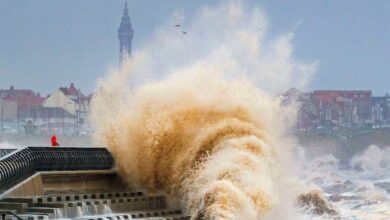Arctic now warming four times faster than rest of the world, scientists say

The Arctic is warming four times faster than the rest of the world, raising the stakes of the climate crisis for the entire planet.
Scientific bodies like the US National Oceanic and Atmospheric Administration (NOAA) have previously said that the northern reaches of the planet are heating up twice as fast as other regions.
But the new results, published on Thursday in the journal Communications Earth & Environment, found that the Arctic as a whole has warmed much faster than that in the past four decades.
Global temperatures are rising due to human-caused greenhouse gas emissions, mainly from the use of fossil fuels.
The new research comes a day after staggering findings from the other side of the world. An international team of scientists published research on Wednesday that the East Antarctic Ice Sheet, known as the “sleeping giant”, could singlehandedly raise sea levels by up to five metres (16 feet) in the next few centuries if planetary heating continues apace.
Sea level rise is also being driven by warming in the Arctic, which has helped melt the vast Greenland ice sheet – meaning warming temperatures at both poles could have serious ramifications globally.
The new study was started after a series of intense heatwaves in the Arctic in 2020, Mika Rantanen, a climate scientist at the Finnish Meteorological Institute and lead author, told The Independent this week.
Dr Rantanen and his colleagues looked at warming in the Arctic from observed temperature data gathered between 1979 and 2021 across the northern edge of the world.
Since 1979, the Arctic as a whole has warmed 3.8 times as fast as the global average, the authors found.
But the rate of warming wasn’t uniform across the Arctic. In general, areas closer to the North Pole warmed faster than areas further south, the study found.
Some specific locations have gotten hotter extremely quickly. For example, the area around Novaya Zemlya, a group of islands in northeast Russia has been warming around seven times as fast as the global average.
Warming in the Arctic can be detrimental to local people and wildlife as sea ice and permafrost – the permanently frozen ground native to the tundra – melt.
Arctic warming can also speed up the melting of ice sheets and glaciers, which contributes to the global rise in ocean levels.
This speedier warming is a phenomenon known as “Arctic amplification”, and is partly due to melting sea ice, Dr Rantanen explained.
Sea ice melts over the summer, allowing heat from the ocean to move to the atmosphere, Dr Rantanen says. With more open ocean and less sea ice, more heat can transfer to the atmosphere.
That might explain seasonal differences in warming rates. The new study finds that from October – December, the Arctic is warming about five times as fast as the rest of the planet, while the spring and summer months were slower in comparison.
Other factors contributing to Arctic amplification include the dark colour of the open ocean compared to the brilliant, reflective quality of the ice – since darker colours absorb more sunlight than lighter ones, the surface will absorb more heat after ice melts.
In addition, Arctic warming is fuelled by the movement of air and moisture through the atmosphere, climate scientist Matthew Henry writes in Carbon Brief.
The new study builds on recent research that concluded that the Arctic is now warming even faster than previously thought. Another study from earlier this summer appeared to support the new findings, concluding that the Arctic had warmed around four times as fast as the world at times in the past two decades.





